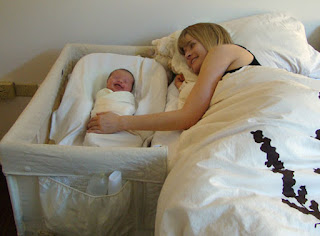Working with infants, I hear all the different options
parent choose for their child’s sleep. These
options include solitary sleep (a child sleeping alone in a crib), and
co-sleeping. Co-sleeping can be any
number of things. There are 3-sided cribs
called co-sleepers that sit up against the side of the parents bed so baby is
safe, but only an arm’s length away from mom.
There is also co-sleeping that involves actually allowing the infant to
sleep in the bed with the parents (this is highly
unsafe and I do not recommend
it).
 | |
| Co-Sleeper |
My best experiences with infants and their sleep have been
with parents who use solitary-sleep methods (a child sleeping alone in his or
her crib). This is not to say that there
aren’t benefits to co-sleeping. Co-sleeping
provides great benefits to the parents, especially the mother if she is nursing,
as well as benefits to the baby having mother very close. This type of sleeping can be very helpful to
the mental state of mom’s with babies that wake frequently in the night to
feed. My most memorable experience with
a family that used a co-sleeper, was centered around the child’s inability to
nap. We came to realize that the child
was sleeping in a co-sleeper at home, and was used to having someone next to her
at all times. This affected her napping
at day care in a negative manner.
Along the lines of my research project, I found a research
article that compares the sleep of co-sleeping and solitary-sleeping infants
(Mao, Burnham, Goodlin-Jones, Gaylor, & Anders, 2004). They analyzed the sleeping and waking
patterns of infants 3-15 months old in both settings. What they found did not surprise me. They found that infants who used
solitary-sleeping methods spent more time asleep AND woke up fewer times during
the night than co-sleeping infants.
This article is exciting to me because it gives me research
to back up what I believe. I plan on
printing a few copies of this article and adding them to a binder of resources
for parents that I keep in my room.
Reference:
Mao, A., Burnham, M. M., Goodlin-Jones, B. J., Gaylor, E.
E., Anders, T. F. (2004). A Comparison
of the Sleep-Wake Patterns of Cosleeping and Solitary-Sleeping Infants. Child
Psychiatry and Human Development, 35(2), 95-106.
